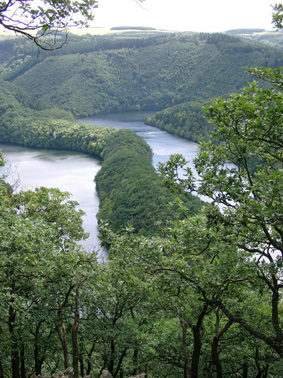Eifel National Park
| Eifel National Park | |
|---|---|
| Nationalpark Eifel | |
|
IUCN category II (national park)
|
|

View from Kermeter of the Urft Reservoir
|
|
|
Germany
|
|
| Location |
North Rhine-Westphalia, |
| Nearest city | Mechernich, Düren, Aachen |
| Coordinates | 50°37′00″N 6°26′00″E / 50.6166667°N 6.4333333°ECoordinates: 50°37′00″N 6°26′00″E / 50.6166667°N 6.4333333°E |
| Area | 10,700 ha (26,400 acres) |
| Established | 1 January 2004 |
| http://www.nationalpark-eifel.de | |
The Eifel National Park (German: Nationalpark Eifel) is the 14th national park in Germany and the first in North Rhine-Westphalia.
The aims of the Eifel National Park accord with those set out by the International Union for Conservation of Nature and Natural Resources, IUCN. These require that at least 75 percent of the national park's area must be left to develop naturally - i.e. must not be given over to human use - within 30 years of the foundation of the park. Aims, mechanisms and executive bodies are laid down in the National Park Regulation (Nationalpark-Verordnung or NP-VO). The relatively young national park lies in the north of the Eifel region between Nideggen in the north, Gemünd in the south and the Belgian border in the southwest. The legal decree by the state that lays the foundation for the park has been in force since 1 January 2004. The area covers about 10,700 hectares (26,000 acres), is bordered to the northwest by the Rur Reservoir and includes the neighbouring Urft Reservoir, the former Vogelsang Military Training Area, but not the Nazi Ordensburg Vogelsang itself. The terrain of the former military training area run by the Belgian Armed Forces and used by NATO troops, the Dreiborn Plateau, forms about 3,300 hectares (8,200 acres) of the entire area and has been open to the public since 1 January 2006.
The Eifel National Park protects the wood-rush and beech woods that flourish in the maritime climate and which have been preserved to this day in parts of the North Eifel, but which originally covered the entire Eifel region as well as large parts of Central Europe. An area of 110 square kilometres (42 sq mi) is covered by deciduous and coniferous woods, lakes, streams and open grassland. One large contiguous stretch of forest with a high percentage of beech woods is the region known as the Kermeter. This forested area is accessible and offers a large number of interesting walks. The Eifel National Park is home to over 7,100 animal and plant species of which 1,800 are classified as endangered on the red list of North Rhine-Westphalia. A total of 1,300 species of beetle alone have been discovered in its woods. Amongst the other forms are wildlife in the park are the wildcat, the black stork, the middle spotted woodpecker and the wall lizard which is a rarity in the state of North Rhine-Westphalia.
...
Wikipedia

